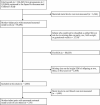Association between maternal blood or cord blood metal concentrations and catch-up growth in children born small for gestational age: an analysis by the Japan environment and children's study
- PMID: 38336787
- PMCID: PMC10858588
- DOI: 10.1186/s12940-024-01061-7
Association between maternal blood or cord blood metal concentrations and catch-up growth in children born small for gestational age: an analysis by the Japan environment and children's study
Abstract
Background: Catch-up growth issues among children born small for gestational age (SGA) present a substantial public health challenge. Prenatal exposure to heavy metals can cause adverse effects on birth weight. However, comprehensive studies on the accurate assessment of individual blood concentrations of heavy metals and their effect on the failure to achieve catch-up growth remain unavailable. This study aimed to evaluate the effects of uterine exposure to toxic metals cadmium, lead, and mercury and essential trace metals manganese and selenium at low concentrations on the postnatal growth of children born SGA.
Methods: Data on newborn birth size and other factors were obtained from the medical record transcripts and self-administered questionnaires of participants in the Japan Environment and Children's Study. The blood concentrations of lead, cadmium, mercury, selenium, and manganese in pregnant women in their second or third trimester were determined by inductively coupled plasma mass spectrometry. These heavy metal concentrations were also assessed in pregnant women's cord blood. Furthermore, the relationship between each heavy metal and height measure/catch-up growth in SGA children aged 4 years was analyzed using linear and logistic regression methods. These models were adjusted for confounders.
Results: We studied 4683 mother-child pairings from 103,060 pregnancies included in the Japan Environment and Children's Study. Of these, 278 pairs were also analyzed using cord blood. At 3 and 4 years old, 10.7% and 9.0% of children who were born below the 10th percentile of body weight had height standard deviation scores (SDSs) below 2, respectively. Cord blood cadmium concentrations were associated with the inability to catch up in growth by 3 or 4 years old and the height SDS at 3 years old. In maternal blood, only manganese was positively associated with the height SDS of SGA children aged 2 years; however, it was not significantly associated with catch-up growth in these children.
Conclusion: Cadmium exposure is associated with failed catch-up development in SGA children. These new findings could help identify children highly at risk of failing to catch up in growth, and could motivate the elimination of heavy metal (especially cadmium) pollution to improve SGA children's growth.
Keywords: Catch-up growth; Heavy metal; Prenatal period; Small for gestational age.
© 2024. The Author(s).
Conflict of interest statement
The authors declare no competing interests.
Figures

Similar articles
-
Association of placental weight at birth with maternal whole blood concentration of heavy metals (cadmium, lead, mercury, selenium, and manganese): The Japan Environment and Children's Study (JECS).Environ Int. 2024 Jun;188:108725. doi: 10.1016/j.envint.2024.108725. Epub 2024 May 13. Environ Int. 2024. PMID: 38759546
-
Individual and mixed metal maternal blood concentrations in relation to birth size: An analysis of the Japan Environment and Children's Study (JECS).Environ Int. 2022 Jul;165:107318. doi: 10.1016/j.envint.2022.107318. Epub 2022 May 23. Environ Int. 2022. PMID: 35679738
-
Maternal Metals Exposure and Infant Weight Trajectory: The Japan Environment and Children's Study (JECS).Environ Health Perspect. 2022 Dec;130(12):127005. doi: 10.1289/EHP10321. Epub 2022 Dec 14. Environ Health Perspect. 2022. PMID: 36516017 Free PMC article.
-
International Small for Gestational Age Advisory Board consensus development conference statement: management of short children born small for gestational age, April 24-October 1, 2001.Pediatrics. 2003 Jun;111(6 Pt 1):1253-61. doi: 10.1542/peds.111.6.1253. Pediatrics. 2003. PMID: 12777538 Review.
-
Latin American consensus: children born small for gestational age.BMC Pediatr. 2011 Jul 19;11:66. doi: 10.1186/1471-2431-11-66. BMC Pediatr. 2011. PMID: 21771322 Free PMC article.
References
MeSH terms
Substances
LinkOut - more resources
Full Text Sources
Medical

